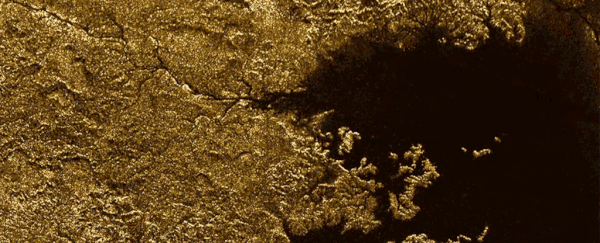Other than Earth, Saturn's largest moon Titan is the only other planetary body in our entire Solar System known to have naturally occurring liquid on its surface.
But unlike our practically perfect planet, Titan's liquid isn't exactly inviting - it's made of super-cold methane, and for the first time, NASA's Cassini spacecraft has spotted deep gorges and complex river systems flooded with the stuff.
If you're not that familiar with Titan, let me paint a picture for you. This icy, desolate moon has a thick, highly pressurised nitrogen and methane atmosphere, and is shrouded in enormous clouds of cyanide.
Its air temperature is about 200 degrees Celsius cooler than Earth's, and on its rocky surface near the north pole, there are three large seas of methane hydrocarbon - Kraken Mare, Punga Mare, and Ligeia Mare. Dozens of smaller lakes surround these three vast oceans.
Besides having very little atmospheric oxygen and no water - and, you know, the whole cyanide thing - Titan is of great interest to astronomers because it's kind of like a bizarro Earth.
It's got land and sea, and in the past, scientists have gone so far as to simulate a cell membrane that doesn't need oxygen to survive or reproduce. Yep, it's theoretically possible for a completely different kind of life to exist on Titan.
NASA's Cassini spacecraft has spent almost two decades investigating Saturn and its peripheries, and the data it's sent back to headquarters has shown indications that its second-largest sea, Ligeia Mare, branches off into flooded rivers and canyons in a Nile River-like formation.
The channels Cassini has spotted - in particular, a complex, 400 km-long network of them called Vid Flumina - appear to be formed from eight extremely narrow canyons that are slightly less than 1 km wide, but an intimidating 240 to 570 metres (790 to 1,870 feet) deep.
Researchers have known about these formations for some time, and thought that maybe the strange dark material inside them could be liquid rather than icy debris, but until now, they've had no way of testing it.
That's where Cassini's radar - and some extremely clever science - come into play.
As NASA explains, the researchers observed the way Cassini's radar signal reflected off the bottoms of the canyon features. The radar observed a "glint", which signals that the canyons have a very smooth surface, likely formed by a liquid, just like in Titan's methane seabeds.
The team also figured out the depths of these canyons by looking at the timing of the radar echoes as they bounced off their edges and floors, which you can see in the gif at the top of the page.
So how did these rivers and canyons form? That part is less clear, but the researchers say there are a couple of possibilities.
"The presence of such deep cuts in the landscape indicates that whatever process created them was active for a long time or eroded down much faster than other areas on Titan's surface," a NASA statement explains, adding that this could have involved either tectonic shifts or changes in sea level, or maybe even both.
The team modelled the likely scenarios for how these channels formed, using similar scenarios here on Earth as a comparison.
As David Lumb explains for Engadget, upward movements in the terrain caused by earthquakes could send liquid from Ligeia Mare punching deeply down, like it did in our own Grand Canyon.
Or, variations in the sea level could have increased the rivers' rate of erosion, like it did in the formation of Lake Powell, which runs off of the Colorado River.
"It's likely that a combination of these forces contributed to the formation of the deep canyons, but at present it's not clear to what degree each was involved," says one of the team, Valerio Poggiali from the University of Rome, Italy.
"What is clear is that any description of Titan's geological evolution needs to be able to explain how the canyons got there."
Cassini will complete its 20-year mission some time next year, but hopefully before then, it will recieve more information from the canyons area. Because Titan is just weird enough that we really don't know what we could find.
The study has been published in Geophysical Research Letters.
